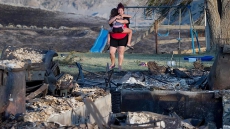With a backdrop of the snow-capped Himalayas stretched out across a vibrant blue sky, it is hard to dispute the sign as you enter Komik that declares it to be the world's highest village with a road.
Others also boast the title — from Nepal's Dho Tarap to Bolivia's Santa Barbara. But at 4,587 metre (15,050 ft), this remote Buddhist hamlet near India's border with Tibet is no doubt among the planet's topmost motorable human settlements.
Yet despite its coveted status, life is harsh for the 130 residents of Komik, a quaint collection of whitewashed mud-and-stone houses located in the desolate Spiti Valley.
The region is a cold trans-Himalayan desert cut off from the rest of India for six months of the year when snowfall blocks mountain passes. Phone and internet connectivity is almost non-existent. Schools and clinics are a tough trek away.
But Spiti's some 12,000 inhabitants, who eke out a living farming green peas and barley, have a much bigger concern: their main sources of water — streams, rivers, ponds — are drying up.
"We are used to being in a remote place. We have our traditional ways of living," said farmer Nawang Phunchok, 32, as he sat tying bundles of a prickly desert bush together to insulate the local monastery's roof.
"But these days the water is not coming like it used to. The seasons are changing. We see there is less water than before." There is little doubt India is facing a water crisis.
Decades of over-extraction of ground water, wasteful and inefficient irrigation practices, pollution of surface water like lakes and rivers, and erratic weather patterns attributed to climate change, have left many parts of the country thirsty.
But while government, charities and media increasingly focus on the drought-stricken farmers in the plains, their Himalayan counterparts — ironically living in a region often called the "Water Towers of Asia" — also need help, say conservationists.





